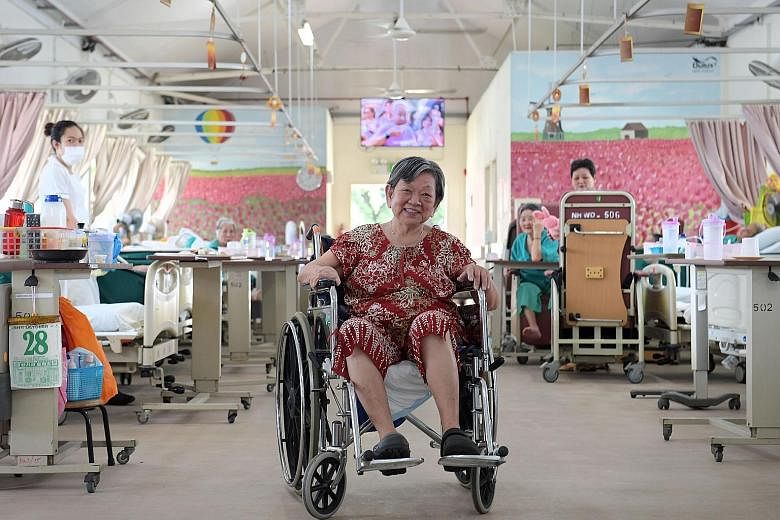For the past 16 years, home for Madam Chew Eng Huay has been a chronic sick ward, and then a nursing home.
A stroke in 2000 left her unable to walk, talk or feed herself, so she went from her sister's flat to the Ren Ci long-term care facility in Hougang. Eight years later, she was wheeled into Ren Ci nursing home in Jalan Tan Tock Seng where she continued to be bed- bound and fed through a tube.
The nursing home is made up of seven single-storey buildings. Madam Chew, 70, lives with 29 others in one of the cavernous rooms.
Her first thought when she was brought in was to go back home. She was fearful of not being able to go wherever she wanted. Today,she seems to be a different person.
It was barely lunchtime when The Sunday Times visited her two weeks ago and "Ah Huay", as she is affectionately called, was already cooking a pot of red bean soup for dessert. She whips up a sweet treat for the residents every Thursday.
"I cook anything, red bean, green bean, chrysanthemum or barley soup," said Madam Chew, brandishing a ladle as she stretched to stir the soup from her wheelchair. She carefully scooped up pandan leaves from the pot with her left hand, as the right side of her body is paralysed.
With intensive rehabilitation and good care, she is now able to talk, eat on her own and wheel herself around by using her left leg to propel the wheelchair forward.
"I like it here, I like everything about this place," she said.
Madam Chew may be one of the many residents of the nursing home, but she enjoys helping the nurses run the place.
During breakfast, she helps to feed one of the residents. Then she transfers herself onto a motorised scooter to go around delivering bedsheets, eggs and bread to residents in other wards. After lunch, she sometimes plays mahjong with her close friends using her one good hand.
"I need to have things to do. It makes me happy," said Madam Chew, who could not sit still even during this interview. Intermittently, she would check on her red bean soup or ensure that someone was feeding a certain resident.
She said she is accustomed to hard work as she used to sell coffee and bread at Lau Pa Sat. Later, she also helped her father sell ice kacang at his hawker stall in Havelock Road.
Madam Chew is single and has an older sister and an estranged younger brother. Their father left them a three-room flat in Bukit Ho Swee, which they sold.
"I don't like to stay alone at home as I am scared. What if I die and no one finds me even after one or two weeks?" she said in Mandarin.
"Even if there are care workers who can come to my home to help, I don't think they are able to do so every day," she added.
She said she does not mind sacrificing personal space and privacy. One neighbouring resident, she pointed out, scolds her each time she passes by and another rambles on about winning the lottery.
She has injected her personality into the impersonal space by pasting Hello Kitty and other cartoon stickers on the cupboard next to her bed. And she wears red and black floral blouses and trousers instead of the green pyjamas that everyone else wears. A nurse from Myanmar, who treats her "like mum", bought the outfits for her.
Madam Chew, with her cheerful disposition and active lifestyle, may be an exception in her ward. The other residents seem listless and stay in their beds or chairs.
"I used to work so hard in the past and didn't have time to help others. So this is my form of volunteer work now," said Madam Chew.
Nursing homes: Mega, multi-storey facilities being built in rush to increase number of beds
For the past few months, motorists driving along Ang Mo Kio Avenue 1 near Bishan-Ang Mo Kio Park would have seen the new Ren Ci Nursing Home taking shape. When the 11-storey building is completed around next June, it will house up to 470 residents.
Meanwhile, in Chinatown, beds and blood-pressure measuring machines have replaced desk and dusters at a former primary school. The Pearl's Hill Care Home, which officially opened in September, is Singapore's first government-run nursing home.
From constructing new buildings to refurbishing old ones, Singapore is expanding the number of nursing home beds in a hurry.
Singapore has around 12,000 nursing home beds, up from 9,200 in 2010. Another 5,000 will be added by 2020, an increase of 85 per cent over 10 years.
By financial year 2015, the Government was spending $360 million on nursing homes, most of it for patient subsidies, manpower costs and construction. This is more than three times what it spent in financial year 2011.
The pressure to ramp up capacity rapidly has led to two heavyweights - the Government and the National Trades Union Congress - jumping into the segment to run their own nursing homes.
By next year, Kwong Wai Shiu Hospital will have Singapore's largest nursing home in a new 12-storey hub that will see a doubling in its number of beds to 622. An 11-storey, 342-bed home in Chai Chee run by NTUC Health Co-operative and a 290-bed home in Hougang run by Thye Hua Kwan Moral Society are expected to be ready this year.
Such massive projects have led observers to ask whether Singapore is churning out cookie-cutter nursing homes with soulless dormitory-style wards.
Pearl's Hill Care Home, for example, has four large halls for 32 residents each. The Ministry of Health, which runs the home, declined Insight's request for a visit.
Dr Phillip Yap, a geriatrician who has published research papers on nursing homes here, says: "Dormitory living and regimented routines are the norm. Residents have little control over their daily routines and there is minimal privacy."
Meanwhile, the MOH has tried to improve the quality of care in nursing homes by introducing the new Enhanced Nursing Home Standards (ENHS) as part of licensing requirements. Nursing homes were given one year - ended April this year - to comply. Ms Loh Shu Ching, chief executive of Ren Ci Hospital, notes: "The ENHS will definitely provide safer care for the nursing homes but it is going to make things more difficult for those of us trying to turn the nursing home into a home and not a hospital."


